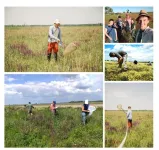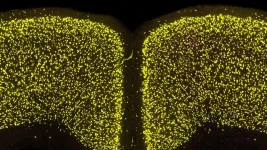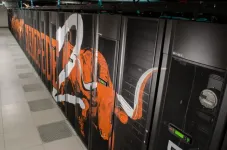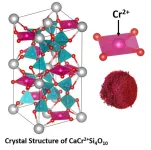(Press-News.org) A nearby supernova in 2023 offered astrophysicists an excellent opportunity to test ideas about how these types of explosions boost particles, called cosmic rays, to near light-speed. But surprisingly, NASA’s Fermi Gamma-ray Space Telescope detected none of the high-energy gamma-ray light those particles should produce.
On May 18, 2023, a supernova erupted in the nearby Pinwheel galaxy (Messier 101), located about 22 million light-years away in the constellation Ursa Major. The event, named SN 2023ixf, is the most luminous nearby supernova discovered since Fermi launched in 2008.
“Astrophysicists previously estimated that supernovae convert about 10% of their total energy into cosmic ray acceleration,” said Guillem Martí-Devesa, a researcher at the University of Trieste in Italy. “But we have never observed this process directly. With the new observations of SN 2023ixf, our calculations result in an energy conversion as low as 1% within a few days after the explosion. This doesn’t rule out supernovae as cosmic ray factories, but it does mean we have more to learn about their production.”
The paper, led by Martí-Devesa while at the University of Innsbruck in Austria, will appear in a future edition of Astronomy and Astrophysics.
Trillions of trillions of cosmic rays collide with Earth’s atmosphere every day. Roughly 90% of them are hydrogen nuclei – or protons – and the remainder are electrons or the nuclei of heavier elements.
Scientists have been investigating cosmic ray origins since the early 1900s, but the particles can’t be traced back to their sources. Because they’re electrically charged, cosmic rays change course as they travel to Earth thanks to magnetic fields they encounter.
“Gamma rays, however, travel directly to us,” said Elizabeth Hays, the Fermi project scientist at NASA’s Goddard Space Flight Center in Greenbelt, Maryland. “Cosmic rays produce gamma rays when they interact with matter in their environment. Fermi is the most sensitive gamma-ray telescope in orbit, so when it doesn’t detect an expected signal, scientists must explain the absence. Solving that mystery will build a more accurate picture of cosmic ray origins.”
Astrophysicists have long suspected supernovae of being top cosmic ray contributors.
These explosions occur when a star at least eight times the Sun’s mass runs out of fuel. The core collapses and then rebounds, propelling a shock wave outward through the star. The shock wave accelerates particles, creating cosmic rays. When cosmic rays collide with other matter and light surrounding the star, they generate gamma rays.
Supernovae greatly impact a galaxy’s interstellar environment. Their blast waves and expanding cloud of debris may persist for more than 50,000 years. In 2013, Fermi measurements showed that supernova remnants in our own Milky Way galaxy were accelerating cosmic rays, which generated gamma-ray light when they struck interstellar matter. But astronomers say the remnants aren’t producing enough high-energy particles to match scientists’ measurements on Earth.
One theory proposes that supernovae may accelerate the most energetic cosmic rays in our galaxy in the first few days and weeks after the initial explosion.
But supernovae are rare, occurring only a few times a century in a galaxy like the Milky Way. Out to distances of around 32 million light-years, a supernova occurs, on average, just once a year.
After a month of observations, starting when visible light telescopes first saw SN 2023ixf, Fermi had not detected gamma rays.
“Unfortunately, seeing no gamma rays doesn’t mean there are no cosmic rays,” said co-author Matthieu Renaud, an astrophysicist at the Montpellier Universe and Particles Laboratory, part of the National Center for Scientific Research in France. “We have to go through all the underlying hypotheses regarding acceleration mechanisms and environmental conditions in order to convert the absence of gamma rays into an upper limit for cosmic ray production.”
The researchers propose a few scenarios that may have affected Fermi’s ability to see gamma rays from the event, like the way the explosion distributed debris and the density of material surrounding the star.
Fermi’s observations provide the first opportunity to study conditions right after the supernova explosion. Additional observations of SN 2023ixf at other wavelengths, new simulations and models based on this event, and future studies of other young supernovae will help astronomers home in on the mysterious sources of the universe’s cosmic rays.
Fermi is an astrophysics and particle physics partnership managed by Goddard. Fermi was developed in collaboration with the U.S. Department of Energy, with important contributions from academic institutions and partners in France, Germany, Italy, Japan, Sweden, and the United States.
END
NASA’s Fermi mission sees no gamma rays from nearby supernova
2024-04-16
ELSE PRESS RELEASES FROM THIS DATE:
Neutrons rule the roost for cage-free lithium ions
2024-04-16
An international team of scientists found a way to improve battery design that could produce safer, more powerful lithium batteries.
The team used quasi-elastic neutron scattering at Oak Ridge National Laboratory to set the first benchmark, one-nanosecond, or one billionth of a second, for a mixture of lithium salt and an organic polymer electrolyte.
“It all comes down to the study of materials,” said Eugene Mamontov, ORNL Chemical Spectroscopy group leader. “And polymer electrolytes won’t catch fire the way liquid electrolytes do in lithium batteries.”
The team used the neutron technique to validate computer ...
Common HIV treatments may aid Alzheimer’s disease patients
2024-04-16
Alzheimer’s disease (AD) currently afflicts nearly seven million people in the U.S. With this number expected to grow to nearly 13 million by 2050, the lack of meaningful therapies represents a major unmet medical need. Scientists at Sanford Burnham Prebys have now identified promising real-world links between common HIV drugs and a reduced incidence of AD. The study, led by Jerold Chun, M.D., Ph.D., was published in Pharmaceuticals.
Chun’s new research builds on his lab’s landmark ...
Turner to receive funding for Israel Institute Postdoctoral Fellowship
2024-04-16
John Turner, Professor, Religious Studies, is set to receive funding for: “Israel Institute Postdoctoral Fellowship.”
This funding will support a postdoctoral teaching fellow for three (3) academic years starting in fall 2024.
Regarding the importance of this funding, Turner said, “Curricula across academic units at George Mason contain very little material about the modern State of Israel, a significant gap given the importance of the nation and region to contemporary politics and conflict. This grant will enable RELI to address this gap and add content on this important subject.”
Turner will receive $248,460 from Israel ...
How AI improves physician and nurse collaboration
2024-04-16
With large language models that take notes during patient visits and algorithms that identify disease, artificial intelligence has begun to prove its worth as an assistant for physicians. But a new study from Stanford Medicine shows the potential of AI as a facilitator — one that helps doctors and nurses connect to achieve more efficient, effective patient care.
The study, which published in JAMA Internal Medicine last month, describes an AI-based model in use at Stanford Hospital that ...
Diverse native wildflower plantings for pollinators in farmlands
2024-04-16
Pollinators are declining rapidly, largely due to land conversion and intensification of agriculture. To mitigate their crisis, low-disturbance habitats, such as sown wildflower plantings (commonly known forms are wildflower strips at the edges of arable fields), could promote pollinators by restoration of their resources (food, sheltering and nesting habitats). However, comprehensive knowledge is lacking on how landscape context, spatial configuration and age of wildflower plantings, seasonality and flower composition affect pollinator communities, especially from East-Central Europe.
To understand these effects, researchers from the HUN-REN Centre for Ecological Research, established ...
Study suggests adolescent stress may raise risk of postpartum depression in adults
2024-04-16
In a new study, a Johns Hopkins Medicine-led research team reports that social stress during adolescence in female mice later results in prolonged elevation of the hormone cortisol after they give birth. The researchers say this corresponds to the equivalent hormonal changes in postpartum women who were exposed to adverse early life experiences — suggesting that early life stress may underlie a pathophysiological exacerbation of postpartum depression (PPD).
The team’s findings, first published online Apr. 11, 2024, in Nature Mental Health, also suggest that current drug ...
New book gathers insights, methods from rising generation of Indigenous archaeologists
2024-04-16
LAWRENCE — A book co-edited by a University of Kansas scholar that collects the experiences and know-how of younger Indigenous archaeologists, titled “Indigenizing Archaeology: Putting Theory into Practice,” is newly published by the University Press of Florida.
Carlton Shield Chief Gover, acting assistant professor of anthropology and acting assistant curator of archaeology at KU, conceived and co-edited the new volume. Its chapters include lessons and case studies from the discipline.
“This is the first book to our knowledge completely comprised of Indigenous scholars in ...
Scientists identify cell vulnerability ‘fingerprint’ related to Parkinson’s, Lewy body dementia
2024-04-16
GRAND RAPIDS, Mich. (April 16, 2024) — A new study from Van Andel Institute scientists offers a first look into the complex molecular changes that occur in brain cells with Lewy bodies, which are key pathological hallmarks of Parkinson’s disease and some dementias.
The findings, published in the journal Nature Communications, reveal that brain cells with Lewy bodies exhibit a specific gene expression pattern akin to a disease-related fingerprint.
“We’ve long known that Lewy bodies play a role in Parkinson’s and other neurodegenerative diseases but there are still many ...
Cooler transformers could help electric grid
2024-04-16
Most people do not give the U.S. electric grid a second thought — we flip a switch and the lights come on. Behind the scenes are thousands of power plants and utilities linked by millions of miles of transmission lines. And to make raw electricity useful, grid transformers convert high voltage to lower voltage that millions of households can plug into.
Transformers are aging and approaching an average of being 30 to 40 years old. Plus, they face more stress than ever before brought on by factors such as renewable energy and by extreme weather events such as hurricanes, heat waves, and winter storms. Case in point — the 2021 event in Texas that ...
Oregon State researchers advance pigment chemistry with moon-inspired reddish magentas
2024-04-16
CORVALLIS, Oregon – An Oregon State University researcher who made color history in 2009 with a vivid blue pigment has developed durable, reddish magentas inspired by lunar mineralogy and ancient Egyptian chemistry.
Mas Subramanian, distinguished professor of chemistry, and collaborators at OSU report the findings of the study, funded by the National Science Foundation, in the journal Chemistry of Materials.
The new pigments, which could be used as energy-efficient coatings for vehicles and buildings, are based on divalent chromium, Cr2+, and are ...








